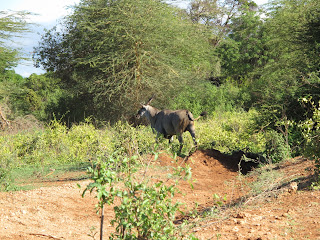Who cares about the conservation of the small and degraded piece of forest that is Shimoni East? Well, not a lot of people out of GVI and FSF... but some of them do. For instance, the elders from the village. The ones that still go to the remote sanctuaries in the forest, known as
"kayas" to pray and practice their traditional beliefs. Some of them, over a hundred years old, have been adventuring onto the depths of the forest for decades to arrive to this sacred places, even in the times (not so long ago) in which you could encounter dangerous animals such as elephants and hyenas in between the trees.
So what are exactly this places? They are a particular spot of the forest, generally a clearing or a cave, in which a spirit lives (or is supposed to live). So people go to this places in order to pray, ask for things or give thanks for things the spirit has done for them. They are not particularly striking or distinct from the surrounding woods, but they have been chosen by the spirits to live in them.
The person that approaches the Kaya, generally an old man, goes there at night, often naked. It stops in the "door" of the Kaya, to ask for permission to enter to the main place. The permission is granted in exchange for a small sacrifice, which is most of times a bottle of rosewater (that's why there are a lot of glass bottles in this particular spot) but that, in times, could be even a human sacrifice. Obviously, this is not practiced any longer. I hope.
Then, the person can access to the Kaya itself. There, it is the place for praying, asking for help or giving thanks. The believer shall carry a colored bracelet according to the purpose of its visit: black, red or white, depending whether it asks for the help in the resolution of a conflict, ask a good, give thanks...
In some cases, the spirit may even decide to show himself to the believer, in different shapes. It may be even the shape of a male lion, approaching the old man while praying naked in the night darkness of the deep forest...but we all know that there are no lions in the Shimoni forest.
 |
| Hassan, the forest guide, leading the way to the Kayas. |













































